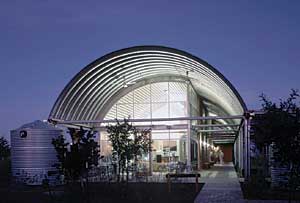New Technologies Create New Challenges
This condition led to the use of details that restrain textiles continuously along each edge. The most commonly used techniques are found in sail technologies; these use a cable or compressible filler (such as a neoprene or other high-density polymer) around which the fabric is wrapped and then slipped into a slotted metal tube. Most mainsails are restrained along their vertical edges in just this way. Other techniques also use an edge cable restraint and reinforced panels with embedded carbon and higher-strength fibers anchored back to points of restraint on the structure.
Detailing multilayered fabrics in this way changes the nature of the building design process. Designs can attempt a continuous textile surface employing a variety of textiles (Teflon-coated PVC, glass fibers, aramid textiles, for example). This is achieved by splicing together the edges of these various materials and restraining the assembly with an aluminum framework set at the edge of the slab. Because textiles can extend many hundreds of yards, the framework can be placed infrequently-only where it is needed at corners and other geometric discontinuities.
Another approach uses the notion of "scales" of fabric to cover the exterior surface of a building. Again, these areas of textile-covered wall are restrained in tension and brought back to the structural support of the building using an intermediate aluminum framework. However, in this case, the scales are more easily adapted to various configurations to respond to the changing conditions of the seasons and the daily needs and preferences of the occupants.
The governing principle behind assembly says the material should be continuous-or put another way, employ as few cuts as possible, in order to avoid intrusive fasteners. The benefit of textiles is that they can be continuous. Prefabrication allows for rolls up to 300 yards to be delivered to the site and attached with continuous channels. Fernandez concluded that it would be possible to close a building in one tenth the time of a conventional glass-and-metal frame assembly. The next step is to find a proof-of-concept opportunity (and validation of process) with a real client and project. Fernandez is looking for a commercial office building in which 85 percent of the envelope construction would be traditional, while the remaining sections would consist of textile.
The practitioner
In contrast to Fernandez's applied research into nontraditional materials, San Antonio−based architects Lake/Flato's work relies on established materials and traditional methods of construction. On a stylistic level, the firm fuses down-home Texas practicality with a Modernist vocabulary, as shown in the two projects presented here. But at a deeper level, the process is driven by a commitment to sustainability principles and practices. The Lake/Flato method, however, does not rely on a checklist of independent, quantifiable sustainable features. Instead, its success comes from combining and overlapping these features, thus activating additional benefits that the architects control. In other words, Lake/Flato seeks a whole that is greater and greener than the sum of its LEED-approved parts.
The firm often wins commissions for projects that introduce man-made structures into environmentally fragile areas. In one unusual case, the Texas Parks & Wildlife Service commissioned the firm to design headquarters for the World Birding Center on a site adjacent to the Bentsen Rio Grande State Park in Mission, Texas, a major flyover path for local and migratory birds. At one time, the site was fragile. Then it was decimated. As principal David Lake, FAIA, recalls, "Over the decades, a colonial attitude prevailed, and the Lower Rio Grande Valley was clear-cut for agricultural purposes to the point where less than 5 percent of the natural habitat remained." Although this deforested area might not be impregnated with the contaminants necessary to qualify the site as a brownfield, Lake says they viewed what once was a rich river delta, now an old onion field, as if it were one.










